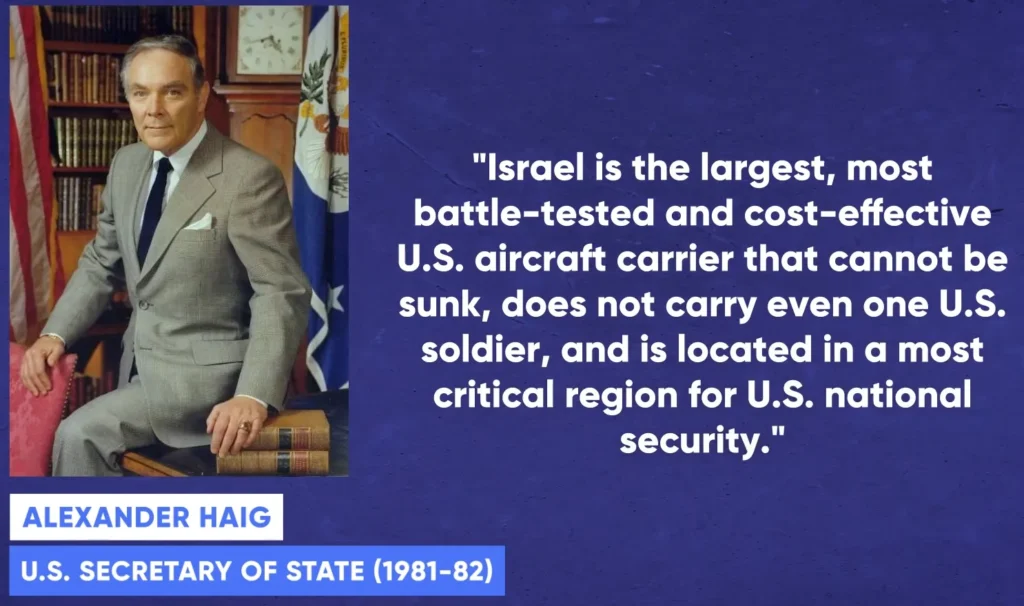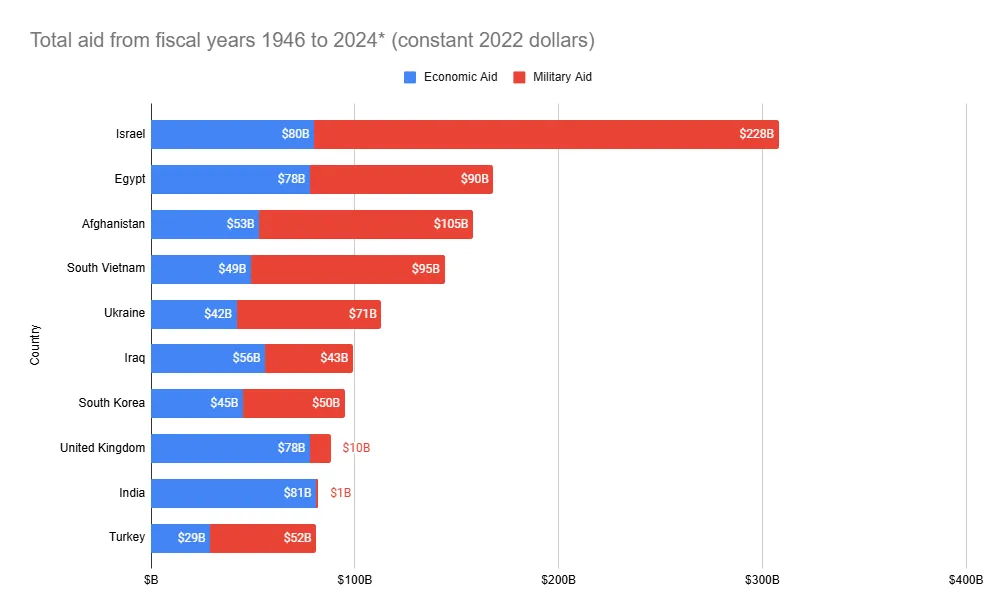A recent study by the Watson Institute reveals that since the October 7 massacre, the U.S. has provided nearly $23 billion in military aid, funding 70% of Israel’s wartime efforts. With additional agreements worth $20 billion already announced, U.S. aid to Israel has reached unprecedented levels.
This marks the past year as the highest in the history of their bilateral relations, underscoring the unparalleled closeness between the two nations. But how did Israel come to enjoy such extraordinary support from the United States?
In this article, we will conduct an in-depth examination of U.S. military aid to Israel, its history, and the benefits the United States derives from ensuring Israel’s supremacy in the region.
In this article:
- The Historical Context of U.S. Aid to Israel
- How Does U.S. Military Aid to Israel Work?
- How Much Aid Does the U.S. Give to Israel?
- How the U.S. Benefits: Jobs, Tech, and Influence
- Beyond the Dollars: A Close Alliance
- Conclusion
Let’s dive in!
The Historical Context of U.S. Aid to Israel
The U.S.-Israel relationship began in 1948 when President Harry Truman recognized Israel just 11 minutes after its declaration of independence. Despite his documented antisemitic biases, Truman made this decision under the influence of Zionist leader Chaim Weizmann and his Jewish friend Eddie Jacobson.
Initially, U.S. involvement with Israel was minimal. During the 1956 Suez Crisis, the U.S., under President Eisenhower, opposed Israel’s alliance with Britain and France against Egypt. However, this changed after Israel’s decisive victory in the 1967 Six-Day War. The war demonstrated Israel’s military strength and highlighted its potential as a strategic ally during the Cold War. Both nations shared geopolitical interests and democratic values, which deepened their connection.
The 1973 Yom Kippur War further strengthened U.S.-Israeli ties. Egypt and Syria launched a surprise attack on Israel. In response, the U.S. initiated Operation Nickel Grass, delivering crucial military support. This assistance helped Israel overcome its adversaries and reinforced the importance of maintaining its “Qualitative Military Edge” in the region.
The U.S. saw Israel as a vital ally in the fight against Soviet influence in the Middle East, as both Egypt and Syria were heavily backed by the Soviet Union. Supporting Israel not only ensured its survival but also helped the U.S. counterbalance Soviet power in the region. However, the aid prompted an Arab oil embargo, which led to the 1973 oil crisis.
Post-1973 Yom Kippur War
After the Yom Kippur War, U.S. aid to Israel increased dramatically. In 1981, President Ronald Reagan formalized the relationship with the Strategic Cooperation Agreement, designed to counter Soviet influence in the Middle East. Reagan’s Secretary of State, Alexander Haig, described Israel as “the largest, most battle-tested, and cost-effective U.S. aircraft carrier that cannot be sunk.” During this time, Israel was also designated as a “major non-NATO ally,” solidifying its role as a vital regional partner.

In the 1990s, following the collapse of the Soviet Union and Iraq’s invasion of Kuwait, U.S.-Israeli cooperation deepened. The U.S. increasingly relied on Israel as a strategic partner to address regional challenges. This partnership became even more vital after the September 11, 2001, terrorist attacks, as both nations intensified their focus on combating terrorism and ensuring regional stability.
Despite occasional political disagreements, such as those between President Barack Obama and Prime Minister Benjamin Netanyahu, the U.S.-Israel relationship remains strong. Shared values and strategic interests bind the two nations. Consistent public support in the United States ensures the partnership remains a cornerstone of U.S. Middle East policy.
How Does U.S. Military Aid to Israel Work?
U.S. military aid to Israel is primarily provided through Foreign Military Financing (FMF) grants. These are not direct cash handouts but rather grants that countries can use to purchase military equipment and services from U.S. defense contractors. In other words, they are essentially military “coupons” from Uncle Sam.
Once spent, the funds flow back into the U.S. economy, creating jobs in manufacturing, engineering, and other sectors. FMF grants are not exclusive to Israel, and other countries also receive FMF funding, including:
- Egypt
- Jordan
- Iraq
- Philippines
- Lebanon
- Colombia
- Tunisia
- Ukraine
- Poland
- Various NATO members
Unlike other countries, Israel has historically been allowed to allocate a portion of its FMF aid toward purchasing equipment from Israeli defense firms—a privilege not extended to other recipients of U.S. military aid. However, this provision is set to be gradually phased out in the coming years.
How Much Aid Does the U.S. Give to Israel?
The Council on Foreign Relations estimates that between 1946 and 2024, Israel has received more U.S. foreign aid than any other country, with total economic and military assistance amounting to an estimated $310 billion, adjusted for inflation.

Between 1971 and 2007, Israel received substantial assistance from the United States in both economic and military aid. In the 1990s, as Israel experienced significant economic growth, the U.S. gradually phased out its economic assistance in favor of military aid. This shift was mutually agreed upon by both nations.
2007’s Memorandum of Understanding (MOU)
On August 16, 2007, Israel signed a Memorandum of Understanding (MOU) with the United States to increase security assistance to $30 billion over a ten-year period starting in 2008. In practice, the U.S. provided even greater support during these years, including additional grants for the Iron Dome project and other defense initiatives.
For instance, in 2014, U.S. aid totaled $3.6 billion, with $235.3 million allocated specifically for the Iron Dome. In 2015, U.S. aid rose to $3.7 billion, including $351 million for the Iron Dome and $269 million each for the Arrow and David’s Sling missile defense systems.
- Iron Dome for short-range rocket interception
- David’s Sling for medium-range threats
- Arrow system for long-range ballistic missile defense
2016’s Memorandum of Understanding (MOU)
In 2016, during President Obama’s tenure, the United States and Israel signed a ten-year MOU, committing $38 billion in military aid from 2019 to 2028. This package allocates $3.8 billion annually, making it the largest U.S. security assistance package ever granted to any country.
The memorandum specifies that $33 billion is allocated as Foreign Military Financing (FMF) grants, which Israel uses to purchase advanced U.S.-made defense equipment. This includes cutting-edge F-35 stealth fighter jets, which provide Israel with unparalleled air combat capabilities, as well as precision-guided munitions and other high-tech weaponry essential for maintaining its military advantage.
An additional $5 billion is dedicated to the Israeli missile defense systems, the Iron Dome, David’s Sling, and the Arrow system.
As part of the agreement, the U.S. required a phase-out of previous provisions allowing a portion of the funds to be spent on Israeli-made equipment and fuel. By 2028, all $3.8 billion per year must be spent on U.S.-manufactured defense products.
How the U.S. Benefits: Jobs, Tech, and Influence
Jobs and Factories in the U.S.
Because Israel can only spend these grants on U.S. products, the money circles back into American industry. It’s often said that foreign aid for Israel doesn’t leave American shores; it funds the manufacturing of planes, tanks, and missiles in the U.S. defense sector. This, in turn, pays workers’ wages, boosts local economies, and sustains about 20,000 American jobs directly or indirectly. Businesses from large defense contractors to smaller specialized parts suppliers profit from these annual deals.
Israel as a Test Bed for U.S. Weapons
Another key U.S. advantage is using Israel’s battle environment to test American weapons. Whether it’s the Iron Dome intercepting rockets or updated F-35 jets flying missions, the United States gains real-time data on how their technology performs. Israel’s conflicts, including the ongoing Israel Hamas war in Gaza, often showcase American arms in fast-paced battle scenarios. Lessons learned can inform adjustments to design, tactics, and future development. This valuable feedback can’t be replicated easily, even in the best simulation labs.
The best example of this is when Zivi Nedivi, a pilot in the Israeli Air Force, managed to land an F-15 without one of its wings—a feat that should be aerodynamically impossible. The incident occurred on May 1, 1983, and was so shocking that McDonnell Douglas sent a team to Israel to investigate. The incident taught both Israel and the United States valuable lessons about the F-15 and how much damage it can withstand if push came to shove.
Ensuring Dependence
Providing weapons also deepens Israel’s reliance on American hardware. Since the Israel Defense Force uses mostly U.S. arms, it needs American parts, updates, and training. This dependence boosts Washington’s clout in the region—Israel is less likely to shift away from U.S. strategic interests when relying on American support.
Of course, this sometimes comes at the expense of Israeli security needs. It’s not the first time Israel has had to cancel its own in-house projects to ensure steady support from Uncle Sam. Two notable examples are:
- The Lavi project in the 1980s – an Israeli attempt to build a domestic fighter jet.
- The Sholef project – an Israeli effort to develop a self-propelled howitzer.
Both projects would have made Israel significantly less reliant on the U.S., but were cancelled following American pressure. I’ll elaborate on this in future articles.
Beyond the Dollars: A Close Alliance
Though it comes with large financial commitments, military aid to Israel remains popular in the Biden administration and in Congress. Policymakers see it as a solid investment in regional stability, advanced R&D for weapons sales, and closer U.S.-Israel cooperation. When the U.S. invests in systems like the Iron Dome or David’s Sling, it learns from how these interceptors handle threats and can integrate those improvements into its own arsenal. Joint programs like these help the U.S. maintain its edge over adversaries in high-tech defense.
For Israel, consistent American backing is crucial. Surrounded by hostile actors, it faces rocket attacks and militant groups on multiple fronts. This relationship, anchored by U.S. aid, helps preserve the upper hand. It also cements Israel’s position as one of the most potent militaries in the region, able to counter Iranian influence and potential threats from Hezbollah, Hamas, and beyond. And for the U.S., having a battle-tested partner in the Middle East is a valuable security asset.
Conclusion
U.S. foreign military assistance to Israel might look enormous in raw numbers, but it isn’t a blank check. It’s more like highly regulated “military coupons” that strengthen both nations. By design, the funds loop right back into the U.S. economy, creating tens of thousands of American jobs, propping up factories, and supporting sales to Israel that keep the U.S. defense industry thriving. In return, America gets a crucial partner whose commitment to Israel’s security aligns with U.S. interests, a real-world weapons testing site, and a regionally dominant ally that depends on American arms.
Through decades of weapons sales and training, Israel’s arsenal is now deeply linked to U.S. technology, ensuring that decisions in Jerusalem often factor in Washington’s aims. The result is a close alliance that both sides see as mutually beneficial: Israel maintains its Israeli military advantage, while the U.S. profits economically and gains strategic influence.
In times of crisis, such as the Israel Hamas conflict, the Biden administration reaffirms its support, underscoring that U.S. military aid to Israel isn’t just about giving—it’s about an enduring partnership that shapes the Middle East and protects American interests around the globe.

